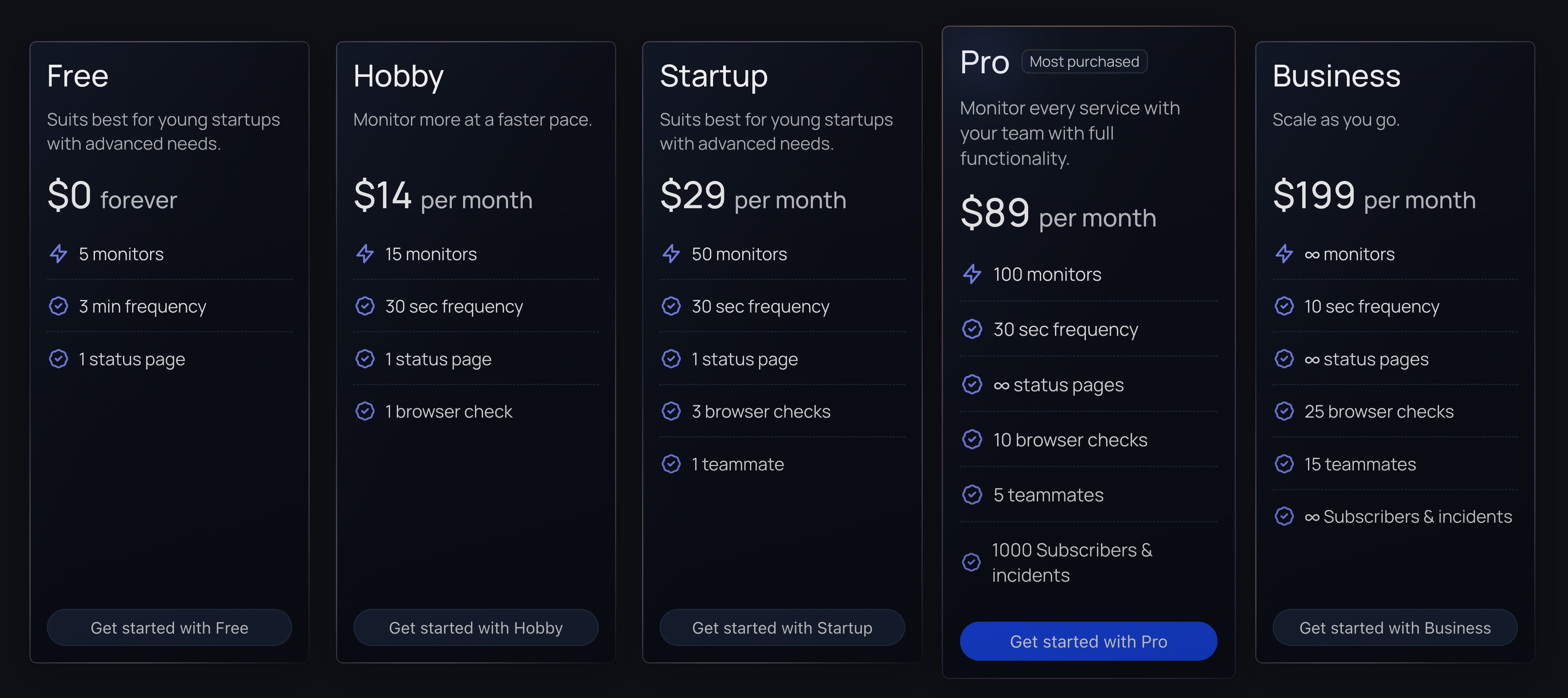You're probably aware that downtime is expensive—but do you know how expensive it is?
The short answer is—very. According to the Ponemon Institute, outages cost organizations an average of $9,000 per minute (or $540,000 per hour). That's why companies of all sizes are investing in incident management tools to reduce their downtime and improve the customer experience.
In this article, we'll be introducing you to eight of the best incident management tools available—including Hyperping, of course. By the end, you'll have a solid understanding of what's out there and how to choose the right one for your business.
Ready to improve your incident response process? Let's dive in.
What Are Incident Management Tools?
Incidents have a way of revealing flaws in systems and processes that teams may not be fully aware of when things are going smoothly—issues like:
- Resource misappropriation
- Communication breakdowns
- Inefficient processes
- Lack of visibility into key components
Incident management tools exist to help IT teams combat these issues. These tools provide a basis for incident response, allows teams to assign tasks and track progress, and provides an overview of system performance.
In short, they help make sure that issues are dealt with as quickly as possible, so you can get back to the important stuff—you know, running your business, serving customers, and iterating your product.
Criteria to Consider When Choosing Incident Management Tools
Choosing software is rarely easy—and choosing an incident management tool is no exception. There are too many considerations and factors to take into account.
Here are a few of the most important:
- Agile Delivery Processes — Does the incident management tool offer rapid deployment capabilities? Does it integrate with other systems, like your continuous integration and delivery (CI/CD) pipelines?
- Real-Time Reporting — Does the software offer detailed reporting capabilities? Are reports provided in real-time (or at least near real-time)?
- Efficiency & Ease of Use — Is the software intuitive and easy to use? Does it save time and resources through automation?
- Integrations & Plugins — Does the tool integrate with existing systems and processes? Are there plugins or extensions that can be added to customize the experience?
Now, let's get to the tools.
8 of the Best Incident Management Tools
If you're looking for the TLDR version, here's a list of the tools we'll be covering, along with what sets them apart from the rest:
- Hyperping — Best for Integrated Status Pages
- Freshservice — Best for Unified IT Service Management
- PagerDuty — Best for Automated Incident Response
- Jira Service Management — Best for Major Incident Workflows
- xMatters — Best for Incident Analytics
- Incident.io — Best for Easy Collaboration
- Squadcast — Best for Automated Actions
- AlertOps — Best for Mobile Incident Management
If you're looking for a more in-depth overview—read on!
1. Hyperping: Best for Integrated Status Pages & Incident Management
Tool silos are a pain when it comes to incident response.
Hyperping eliminates this problem by offering a comprehensive solution that combines status pages, alerting, and incident management—all in one comprehensive tool. It's easy to set up and use, with intuitive dashboards for tracking performance in real-time.
Key Features
- Integrated Status Pages — Keep team members and users in the loop with a beautiful, interactive status page—fully integrated with your incident management and monitoring tools.

- End-to-End Monitoring — Get a comprehensive view of your service with end-to-end monitoring that covers everything from user experience to infrastructure.

- Collaborative Incident Management — Work together to resolve incidents with robust collaboration tools including alert notifications, Slack and Telegram integrations, and real-time updates.

Pricing

Hyperping offers five pricing tiers, ranging from Free to Business. We’re proud of our Free tier, which includes 5 monitors with a 3-minute test frequency. That said, most established businesses will probably want to go with Pro ($89/month) for 100 monitors, unlimited status pages, and 5 teammates.
Pros & Cons
🔥 Pros
- Generous free tier and flat monthly rate
- Integrated status page and monitoring features
- Great integrations
👎 Cons
- Lacks advanced features like workflow creation
2. Freshservice: Best for Unified IT Service Management
Freshservice is a great option for unified IT Service Management (ITSM). It supports a range of IT tasks—from incident management to asset management.
Its user-friendly interface and cloud-based platform help optimize your workflows by automating key processes and managing incidents more efficiently. Plus, it's part of the larger Freshworks ecosystem—a powerhouse when it comes to customer service and engagement.
Key Features
- Unified Service Management — Manage incidents, assets, changes, and problems—all from one platform.
- Automatic Prioritization — Automatically prioritize and route incidents based on severity and other factors.
- Self-Service Portal — Empower your customers with a self-service portal that allows them to find answers and solutions quickly and easily.
Pricing

Freshservice offers four tiers of pricing, ranging from Starter ($19/user/month) to Enterprise ($199/user/month). Starter offers great value with SLA management, solid analytics, and 1000 orchestration transactions per month, per account.
Pros & Cons
🔥 Pros
- Offers a comprehensive ITSM solution
- User-friendly interface and cloud-based platform optimize IT workflows
- Part of the larger Freshworks ecosystem
👎 Cons
- Limited customization options
- Can be expensive for smaller teams
- Some users have reported slow customer support response times
3. PagerDuty: Best for Automated Incident Response
PagerDuty is a cutting-edge incident management software that emphasizes automation when it comes to incident response. It's a comprehensive solution that covers everything from notification to resolution, and it integrates with hundreds of applications, including Slack, Jira, GitHub, and AWS.
Key features
- Response Automation — Automatically route incidents to the right people, teams, and applications - without any manual intervention.
- ITSM Integrations — Integrates with a range of ITSM tools and services, including ServiceNow, Jira, and Zendesk.
- Major Incident Postmortems — Analyze major incidents and create postmortems to improve incident response in the future.
Pricing

PagerDuty offers four plans—Free, Professional, Business, and Digital Operations. You’ll probably want to go for Professional ($21/user/month), as it includes unlimited international phone and SMS notifications, SSO, and ticketing integrations.
Pros & Cons
🔥 Pros
- Strong emphasis on automation and ML
- Comprehensive solution that covers everything from notification to resolution
- Integrates with hundreds of applications
👎 Cons
- Can be expensive for larger teams
- Some users have reported a steep learning curve
- Some users have reported issues with false-positive alerts
4. Jira Service Management: Best for Major Incident Workflows
Jira Service Management is a versatile tool that helps teams manage incidents, problems, and changes with integrated request forms, automated workflows, and reporting.
The tool simplifies collaboration between IT and other departments and offers a self-service portal for end-users. With Jira Service Management, your team can optimize IT operations and track progress in real-time, providing a seamless and efficient experience for your customers.
Key Features
- Major Incident Workflows — Automate workflows and prioritize major incidents with automated notifications, assignments, and escalations.
- Alerting & On-Call Management — Ensure faster issue resolution with alerting and on-call management for engineers and other staff.
- Reporting & Dashboards — Generate reports and track progress with powerful dashboards and customized reporting.
Pricing

Jira Service Management offers a Free plan for up to three agents—and is currently offering their Standard plan for free, too. That said, Premium ($47/user/month) offers the best value with advanced incident management, unlimited file storage, and asset and configuration management.
Pros & Cons
🔥 Pros
- Versatile tool that helps teams manage incidents, problems, and changes
- Offers a self-service portal for end-users
- Can be customized to fit the needs of different organizations
👎 Cons
- Can be complex and overwhelming for some users
- Can be expensive for larger teams
- Some users have reported issues with the user interface and navigation
5. xMatters: Best for Incident Analytics
XMatters is a service reliability platform with many great incident management features.
The focus here is clearly on analytics and data—xMatters helps teams track incidents in real time with a live timeline and generates detailed reports on things like resolution times and root causes. Plus, the tool automates incident assignments to the right individuals or teams based on predefined workflows.
Key Features
- Automated Assignments — Automatically assign incidents to the right individuals or teams based on pre-defined workflows.
- Live Incident Timeline — Easily track incidents with a live timeline that shows who’s working on what, estimated resolution times, and more.
- Incident Analytics — Generate detailed reports and gain valuable insights into incident resolution times, root causes, and more.
Pricing

xMatters offers four tiers of service—Free, Starter, Base and Advanced. The Starter tier is the best value, offering scalable incident response and management for $9/user/month.
Pros & Cons
🔥 Pros
- Provides real-time notifications and alerts to IT teams
- Seamlessly integrates with a wide range of IT tools and offers automated workflows
- Offers detailed incident analytics and reporting
👎 Cons
- Can be expensive for larger teams
- Some users have reported issues with the user interface and navigation
- Some users have reported issues with the level of customization available
6. Incident.io: Best for Easy Collaboration
Incident.io is a centralized incident management platform that really shines when it comes to communication and collaboration.
It offers automated Slack channel creation for every incident, customizable workflows, and dashboards, as well as detailed reporting on incident resolution times and root causes.
Incident.io simplifies communication between incident resolvers, making it a solid choice for teams looking to improve their incident response process.
Key Features
- Automated Slack Channel Creation — Automatically create Slack channels for every incident, ensuring better collaboration between teams.
- Customizable Workflows — Create custom workflows to optimize incident management processes.
- Customizable Dashboards — Generate insights into incident resolution times, root causes, and more with custom dashboards.
Pricing

Incident.io Starter ($16/user/month) is pretty cheap. For access to Pro, you’ll need to pay out over $10,000 per year, though.
Pros & Cons
🔥 Pros
- Comprehensive platform provides real-time alerts, automated workflows, and detailed reporting
- Simplifies communication between incident resolvers
- Offers customizable workflows and dashboards
👎 Cons
- Limited integrations with other IT tools
- Advanced plans are expensive
- No free plan
7. Squadcast: Best for Automated Actions
Squadcast is a solid incident response and management platform focusing on pre-built automation.
It enables teams to automatically assign incidents to the right individuals or teams based on predefined workflows, making it easier to triage incidents and collaborate in real time. With customizable access controls and powerful integrations, Squadcast offers greater efficiency and better collaboration for incident management.
Key Features
- Automated Actions — Automatically assign incidents to the right individuals or teams based on pre-defined workflows.
- Customizable Access Controls — Easily control who has access to which incidents with customizable access controls.
- Powerful Integrations — Integrate with a wide range of IT tools for greater efficiency and better collaboration.
Pricing

Squadcast offers four pricing tiers, ranging from free to $21 per user per month. The Premium tier offers the best value for $16 per user per month, providing rapid and secure incident management.
Pros & Cons
🔥 Pros
- Provides real-time notifications and alerts to IT teams
- Offers automated workflows and detailed reporting
- Helps teams triage incidents and collaborate in real-time
👎 Cons
- Can be expensive for larger teams
8. AlertOps: Best for Mobile Incident Management
AlertOps is a solid incident management solution that enables organizations to optimize their IT operations and enhance their incident response time. With its real-time notifications and mobile-friendly dashboards, AlertOps facilitates seamless collaboration among team members, leading to swift and efficient incident resolution on the go.
Key Features
- Mobile Incident Management — Create and manage incidents on the go with AlertOps’ mobile app.
- Automated Workflows — Easily create automated workflows to streamline incident resolution processes.
- Advanced Reporting — Get detailed insights into incident resolution times, root causes, and more with advanced reporting.
Pricing

AlertOps offers a Starter Pack for free with limited features and three paid tiers: Standard ($5/user/month), Premium ($15/user/month), and Enterprise ($23/user/month). The Enterprise tier is the best for major incident management.
Pros & Cons
🔥 Pros
- Great mobile app for incident management on-the-go
- Offers real-time notifications and a user-friendly dashboard
- Provides advanced reporting and insight into incident resolution times and root causes
👎 Cons
- Can be complex for larger teams to use
- User interface could be improved in certain areas
Improve Your Incident Response Process With Hyperping
Hyperping is the perfect incident management tool for organizations looking to break down tool silos and improve incident response times.
Hyperping’s unified dashboard offers a single place for teams to monitor their IT environment, manage their status pages, and survey their services. Real-time alerts and automated workflows help teams triage incidents quickly, reducing Mean Time To Resolution (MTTR).
If you're ready to take your incident management to the next level, sign up for Hyperping today!


